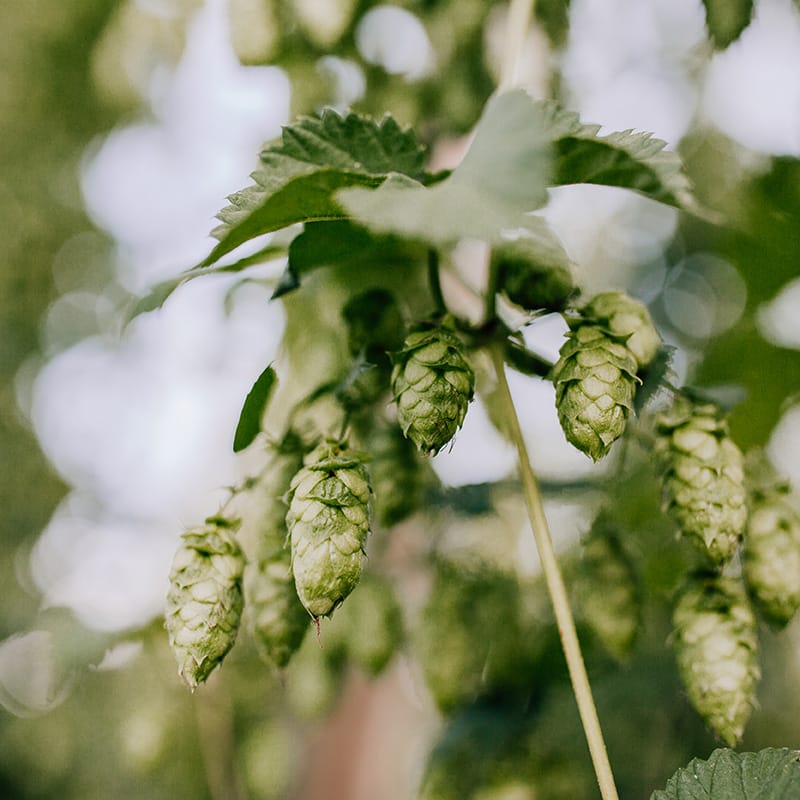• Difficult growing conditions in Europe, early heat wave in Yakima, USA.
• Hop acreage increases in the USA, decreases in Germany, net change +772 ha (1,900 acres) worldwide.
• Heavy hail damage in the Saaz region on some 500 ha (1,250 acres) as well as in the Polish region Wilków, with damages of up to 100%.
I. GROWING CONDITIONS EUROPE
Growing conditions in Europe have been anything but ideal this year. A very cold spring period in April and May was followed by very warm temperatures since the middle of June with initially low levels of precipitation. Towards the end of June storms with heavy rains ensued with a very uneven distribution across the Hallertau and other growing regions.
The cold climate at the beginning of the vegetation period led to a delay in plant growth of about two weeks in comparison to the long-term average. The rising temperatures have shortened the lag to about one week by the end of June. The risk of bloom before the plants reach the top wire and their full growth potential is real, however.
Temperatures Huell in 2021:

Precipitation (Huell) 2021:

Yakima reports an early heat wave during the second half of June with temperature around 35°C. The water reservoirs holding the irrigation water for agricultural use are well filled so that there is currently no reason for serious concern. The early heat could affect baby plantings negatively, however.
II. ACREAGE
Europe:
Somewhat surprisingly the acreage in Europe declines by 93 ha (232 acres) or -0.3%. Germany scales back 86 ha (215 acres) and the UK goes down by 100 ha (250 acres). Slovenia (+55 ha/137 acres) and the Czech Republic (+22 ha/55 acres), on the other hand, increase their acreage.
USA:
The US continues its expansion one more year and adds another 791 ha (1,977 acres / +3.2%). Hop growing outside the core region of the Pacific Northwest (WA, OR, ID) is paired back by 56 ha (-5.6% / 140 acres), however, and drops below the threshold of 1,000 ha (2,500 acres).
Increases are also recorded in the Southern hemisphere in New Zealand (+2.6%) and Australia (+3.6%) while the changes in the other growing regions are insignificant. In total worldwide hop acreage increases by 772 ha / 1,930 acres or 1.2%.
On June 24th a hailstorm ran across parts of the Saaz growing region. A region of approx. 500 ha (1,250 acres) was damaged to varying degrees, in some cases severely (20 – 100%).
Two days later, on June 26th, the Polish growing region around Wilków was hit by a hailstorm, also with heavy damage to some hop fields. We also learned of hail damage in the Austrian region of Mühlviertel, but do not know the extent.
At this fairly early stage of plant development, it is not possible to make a precise prediction of how this damage will affect final yields and the quality of the crop.
IV. MARKETS
The pandemic has hit the beer market to varying degrees, depending on the geographic region and consumption habits. In total beer production shrank by about 5% in 2020 as compared to 2019. In light of this decline 2020 spot prices proved surprisingly robust. Good alpha acid contents in most varieties provided for available spot volumes, which have been continuously marketed since September. After several years of tight markets, the 2020 season was more relaxed and supplies for spot demand were readily available.
Provided crop 2021 yields normally, the comfortable supply situation should continue into the new season. Only for 2023 do we expect beer production to return to pre-pandemic levels. Hop demand, however, should normalize earlier as the return to on-premise consumption, especially in North- America, will boost hop-centric beer styles. As in previous years, the majority of the new crop is already contracted for (>90%). We expect that the industry will once more face a disequilibrium between what is contracted and what is truly needed. Marketers will be called on again to balance the market by directing available volumes to where they are needed. This balancing exercise will range from fairly easy to rather very complicated, depending on the variety under consideration. Not only will quantities play a role, but possible price differentials will need to be taken into account also.





Leave A Comment